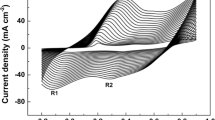Abstract
The copolymers were synthesized with different molar ratios of m-phenylenediamine to aniline (R for short) by a chemical oxidation method. The products were first used as electrochemical activity materials of the supercapacitor. Capacitive behaviors of the prepared copolymers in 1 mol·L−1 H2SO4 electrolyte were examined by electrochemical impedance spectroscopy, cyclic voltammeter, and galvanostatic charge/discharge. The relationship of molar ratios with capacitive property of the prepared products was investigated too. The results showed that the product with R of 2:98 displayed better electrochemical properties than that of the other products. Compared with the synthesized polymer in the absence of m-phenylenediamine, the polymerized copolymer with R of 2:98 exhibited the initial specific capacitance value of 475 F·g−1, which increased by nearly 10.1% than that of the former at a current density of 200 mA·g−1 in 1 mol·L−1 H2SO4 electrolyte in the potential range of −0.3 to 0.7 V. The discharge specific capacitance value of the copolymer remained 300 F·g−1 after 1,000 cycles, exhibiting a good cycling performance and the structure stability.











Similar content being viewed by others
References
Broughton JN, Brett M (2005) Electrochim Acta 50:4814. doi:10.1016/j.electacta.2005.03.006
Yang HS, Zhou X, Zhang QW (2005) Wu li hua xue xue bao 21:414
Mi HY, Zhang XG (2008) J Power Sources 176:403. doi:10.1016/j.jpowsour.2007.10.070
Palaniappan S, Lakshmi Devi S (2008) J Appl Polym Sci 107:1887–1892
Zhang AQ, Cui CQ, Lee JY (1995) Synth Met 72:217. doi:10.1016/0379-6779(95)03304-1
Sun L, Zhang HC (2005) Gao Fen Zi Xue Bao 2:219
Xiang CH, Xie QJ (2006) Synth Met 156:444. doi:10.1016/j.synthmet.2006.01.010
Malinauskas A, Bron M, Holze R (1998) Synth Met 92:127. doi:10.1016/S0379-6779(98)80102-1
Tang HQ, Kitani A, Maitani S, Maitani H (1995) Electrochim Acta 40:849. doi:10.1016/0013-4686(94)00370-G
Lee MH, Luo YC, Do JS (2005) J Power Sources 146:340. doi:10.1016/j.jpowsour.2005.03.116
Prokes J, Stejskal J, Krivka I, Tobolkova E (1999) Synth Met 102:1205. doi:10.1016/S0379-6779(98)01223-5
Quillard S, Louarn G, Buisson JP, Boyer M, Lapkowski M, Pron A (1997) Synth Met 84:805. doi:10.1016/S0379-6779(96)04155-0
Prokeš J, Trchová M, Hlavatá D, Stejskal (2002) Polym Degrad Stabil 78:393. doi:10.1016/S0141-3910(02)00193-3
Tang J, Jing X, Wang B, Wang F (1988) Synth Met 24:231. doi:10.1016/0379-6779(88)90261-5
Zhang H (2005) Modern organic spectrum analysis. Chemical industry press p 287
Deng QY, (2007) Tutorial of spectrum analysis. science press, p 52
Zhu HW (2005) Spectrum analysis of organic molecular structure. Chemical industry press, p 49
Wei Y, Jang GW, Chan CC et al (1990) J Phys Chem 94:7716. doi:10.1021/j100382a073
Wei Y, Tang X, Sun Y et al (1989) J Polym Sci Pol Chem 27:2385. doi:10.1002/pola.1989.080270720
Wei Y, Hariharan R, Patel SA (1990) Macromolecules 23:758. doi:10.1021/ma00205a011
Pouget JP, Jozefowicz ME, Epstein AJ, Tang X, MacDiarmid AG (1991) Macromolecules 24:779. doi:10.1021/ma00003a022
Hu CC, Wang CC (2002) Electrochem Commun 4:554. doi:10.1016/S1388-2481(02)00371-5
Malinauskas A (2001) Polymer (Guildf) 42:3957. doi:10.1016/S0032-3861(00)00800-4
Stilwell DE, Park SM (1988) J Electrochem Soc 135:2254. doi:10.1149/1.2096248
Stilwell DE, Park SM (1988) J Electrochem Soc 135:2491. doi:10.1149/1.2095364
Genies EM, Lapkowski M, Penneau JF (1988) J Electroanal Chem 249:97. doi:10.1016/0022-0728(88)80351-6
Mondal SK, Prasad KR, Munichandraiah N (2005) Synth Met 148:275. doi:10.1016/j.synthmet.2004.10.010
Cao CN, Zhang JQ (2002) Introduction of electrochemistry impedance spectra. science press, p 135
Lewandowski A, Galiński M (2004) J Phys Chem Solids 65:281. doi:10.1016/j.jpcs.2003.09.009
Author information
Authors and Affiliations
Corresponding author
Rights and permissions
About this article
Cite this article
Lu, JF., Wang, L., Lai, QY. et al. Study of capacitive properties in supercapacitor for copolymer of aniline with m-phenylenediamine. J Solid State Electrochem 13, 1803–1810 (2009). https://doi.org/10.1007/s10008-008-0779-9
Received:
Revised:
Accepted:
Published:
Issue Date:
DOI: https://doi.org/10.1007/s10008-008-0779-9




